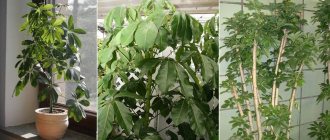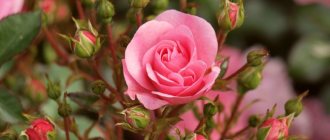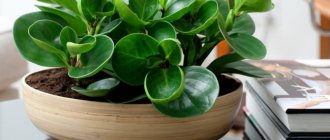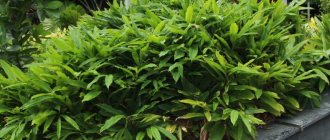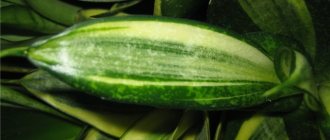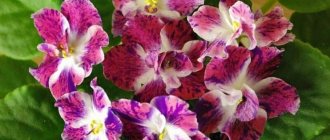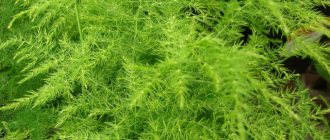Geography of habitat, description of appearance and photo
Peperomia Rosso is native to the tropics of America and Asia. Prefers shaded spaces. Often found in forests. Grows on trees, snags, and peaty soils. Less often - on rocks on a moss floor.
Peperomia Rosso is a shrub about 25 cm high. Its leaves are large and long. They are located close to each other and grow in bunches. The upper part of the leaves is dark green in color, and the lower part is red-burgundy.
Below you can see a photo of the plant:
Peperomia pereskifolia.
There are 2 plants growing in this pot. Both of them are called Pereskolea Peperomia by different sources. It grows quite quickly. Stands in direct sunlight on an eastern window. I water it after drying. Care is similar to that of the blunt-leaved plant.
This is the second one. This is how I bought them last fall.
By now we have already grown up.
Home care
Peperomia Rosso is an unpretentious plant. But, since the natural habitat of this flower is the tropics, caring for it requires some special features.
Temperature
Optimal temperature conditions for growing Peperomia Rosso:
- in spring and summer - from 20 to 22°C;
- in autumn and winter - from 18 to 22°C.
The soil temperature should not fall below 17°C.
Important! Peperomia Rosso is afraid of drafts. Therefore, it is not recommended to take it outside the premises.
Watering
Like all tropical representatives of the flora, Peperomia Rosso loves moisture. The flower needs intensive watering in spring and summer. At other times of the year, it is recommended to reduce the frequency of soil moisture.
Before watering, the water must first be settled. Its temperature should be slightly higher than the ambient temperature (approximately 2 degrees).
Fleshy leaves are able to independently provide themselves with moisture reserves. But if the specimen has delicate foliage and a thin stem, dry air can harm it. Therefore, you should take care of additional hydration by placing containers of water nearby. On hot days it is recommended to spray the plant.
Overwatering can cause leaves to turn black and sometimes cause them to fall off. In this case, it is recommended to stop watering for a week, allowing the soil to dry out.
Light
Since in nature Peperomia Rosso grows in areas shaded from the sun, it is necessary to provide the plant with dim, diffused lighting. The best option is considered to be window sills located in the western and eastern parts of the house.
Priming
Attention! Light and loose soil is considered the most suitable for peperomia. Air permeability of the soil is important for this plant.
Optimal soil composition:
- leaf soil (2 parts);
- peat (1 part);
- coarse sand or perlite (2 parts).
Be sure to use drainage as the bottom layer.
Trimming
Peperomia Rosso does not require pruning, but to preserve the decorative appearance of the flower, it is recommended to remove dry leaves. The procedure consists of the following steps:
- Inspect the plant for dried areas.
- Remove marked leaves and shoots using garden shears.
It is recommended to prune starting from the top of the plant.
Feeding
In winter, peperomia does not need feeding. During other seasons, complex fertilizers are used once every 2-3 weeks.
Pot
Peperomia Rosso prefers tight spaces, so you should choose a small pot. If you plant it in a container that is too large, the flower may slow down the growth of its above-ground part.
For each transplant, it is recommended to use a container 2 cm larger in diameter than the previous one.
Transfer
Reference. In the first 3 years, the flower should be replanted annually in the spring. If it was purchased in winter, it is recommended to postpone the procedure to March. In the future, one transplant every 2-3 years is sufficient.
Procedure:
- Pour drainage into the pot. The optimal layer thickness is 2 cm.
- Fill the container with soil, leaving some free space.
- Carefully remove the plant with a lump of earth from the pot.
- Place the flower in a new container and add soil.
- Water the soil.
- Fill the remaining free space with soil.
It is forbidden to compact the soil by pressing it down. There is a danger of damaging the delicate roots of the flower.
Wintering
In winter, spraying the plant is not recommended. Given the short day, a source of additional lighting should be used. It is very important to control the soil temperature in winter. For insulation, you can lay a felt napkin under the pot. Fertilizing should be excluded or used no more than once every 6 weeks.
Peperomia caperata – Peperomia wrinkled.
I had my eye on this beauty for quite a long time, about two years. Watering is important in caring for it. I water it through a tray with warm water after drying it lightly. Here it is also important not to overdry or overfill. Stands in bright diffused light. The root is not very powerful. The soil for it was used for begonias with a large amount of coconut fiber in the composition. Very loose. At the moment I feed with fertilizers for flowering plants, but as soon as flowering ends, I will switch to fertilizer for deciduous trees. Heat-loving. Unlike relatives with denser leaves, this species loves more humid air. It can be propagated by dividing the bush or leaf cuttings. The second method is more complicated.
Blooms very readily. After purchasing it, I did not replant it immediately. I was still waiting for it to bloom. So 2 months passed. And she kept blooming. After transplantation, flowering became even more active and continues to this day. For 6 months already.
The flowering is not great, but it is unique and interesting!
Reproduction
Peperomia Rosso is propagated by cuttings, bushes and seeds.
Propagation by cuttings:
- Leave a small cutting on the leaf (about 2-4 cm).
- Place it in damp moss. You can use sand.
- After roots have formed (on average after 3 weeks), plant the plant in a pot.
Seed method:
- Fill the container with substrate: sand and leaf soil. Moisturize.
- Sow the seeds.
- Cover the container with glass.
- Ventilate and spray the seedlings 2-3 times a week.
- After sprouts appear and 2 leaves form, transplant the seedlings into another container in increments of 2-3 cm.
- After strengthening and rooting, young plants should be transplanted into separate pots with a diameter of 7 cm.
Bush division:
- Remove the flower from the pot.
- Examine the root and carefully divide it into 2 equal parts.
- Plant the resulting bushes in separate pots.
- Moisten the soil generously.
Important! It is not recommended to use scissors or other tools to divide the bush. The procedure must be performed manually.
Peperomia obtusifolia - Peperomia obtusifolia.
I have a variegated form. I love this plant. Simple beautiful shape and cute color. The plant is very unpretentious. It stands on my sunny eastern window. Air humidity doesn't matter to her. After drying the soil, I water it with warm water, especially in winter, since the plant is heat-loving. Peperomia reacts to excess moisture in the pot with rusty spots on the underside of the leaf. It does not like temperatures below 16, which is not surprising, since it comes from the tropics. It reacts to too cold conditions by falling leaves. In winter, you should not keep it on a cold windowsill. The roots should be warm.
I planted it in cactus soil. It is quite loose, which is suitable for its not very powerful root system. I use fertilizers for cacti and deciduous plants, alternating them.
Propagated by cuttings and seeds, but the first method is simpler.
It grows quite quickly. I only live for a year. It was purchased in a store as a small plant. This is how we grew up!
Diseases and pests
Most peperomia Rosso diseases occur as a result of violation of the rules of care:
- Lack of moisture and low temperatures can cause leaves to fall.
- Drafts are dangerous due to the appearance of brown spots.
- Watering too much can cause the flower to rot.
The following types of parasites are dangerous for Peperomia Rosso:
- mites;
- scale insects;
- nematodes;
- mealyworms.
Possible difficulties during cultivation
Although peperomia is blunt-leaved and undemanding in care, there are a number of difficulties in growing this flower.
If the rules for caring for a plant are not followed, it can be attacked by the following parasites and ailments:
- Spider mite . Appears when there is insufficient watering or dry air. To combat the parasite, you need to increase the humidity of the soil and air near the peperomia by watering and spraying. The water should be warm. Additionally, it is worth treating the plant with Actellica solution.
- Thrips . The main signs of the appearance of these pests are the spread of silvery spots on the leaves. To combat the disease, special drugs are used: Actellik, Fitoverm, Inta-Vir.
- Mealyworms . When infected with worms, fungal mold appears on the stem. To remove it, you need to treat peperomia with Confidor.
- Root system rotting . Happens when watering too much. To prevent this from happening, be careful not to over-water the soil. To eliminate the disease, you will need to transplant the plant into a new pot with new soil.
Peperomia is a beautiful ornamental plant that is unpretentious to grow, but requires regular care. If you follow all the rules of maintenance, you can enjoy this unique plant for a long time, which also has medicinal properties and can bring harmony to your home.
Similar flowers
There are 5 types of peperomia, which are similar to Rosso, but have different shades:
- Peperomia Watermelon. The leaves are colored green and red, characteristic of watermelon.
- Peperomia Marble is distinguished by the presence of burgundy rims and veins on the leaves.
- Tricolor has foliage with a white border.
- Peperomia Wrinkled is distinguished by its bright colors and glossy leaf surface.
- Caperata Lilian has a unique shape - its flowers look like lilies.
Peperomia Rosso is a beautiful exotic indoor plant that does not require special care. It is enough to follow a few simple rules, and the flower will decorate your home for a long time.
Peperomia orba – Round peperomia.
It was love at first sight for us! Elegant lady! The silver stripe in the center of the sheet gives it a special charm.
Just as easy to care for as its predecessors. I only water through the tray after light drying. It is important here not to completely dry out the soil. A very bushy lady. Stands in bright diffused light. Heat-loving.
I use soil for begonias, and fertilizers for decorative deciduous trees.
For the winter - the brightest place
Peperomia requires the same maintenance regime throughout the year. And it depends only on the owners whether it will not wither, become smaller and stretch out in the fall instead of its usual splendor. As soon as daylight hours begin to wane, even plants accustomed to soft lighting and partial shade should be gradually moved closer to the windows. With the expectation that in winter they will be in the brightest place in the house.
If possible, you can compensate for the lack of light with additional lighting, which is increased from October to winter so that the length of daylight is the usual 12 hours.
As soon as the daylight hours begin to wane, the peperomia should be gradually moved closer to the windows. © Ben Kreeger
Peperomia Rosso.
I bought it as soon as I saw it. Since I already had experience with the wrinkled one, then, accordingly, there were no concerns. I replanted it immediately, despite the flowering. But she didn’t even notice. We've been blooming for 5 months now. I take care of it in the same way as I take care of peperomia corrugata.
These are the miracle flowers that appear here!
General information
Peperomia are evergreen herbs that can be annuals or perennials. In addition, there are also subshrubs.
The stems of the plants are thick; they bear thick leaves with a leathery surface. The flowers on the plant are small, but it is still grown as an ornamental plant.
Peperomia is grown at home, but sometimes it can be seen in the garden . Some species not only have beautiful leaves, but also bloom beautifully. But the flowering period begins only if the daylight hours are short.
Peperomia is often part of a composition consisting of several plants.
You can buy Peperomia at a specialized flower shop.
Growing Peperomia
- The light should be diffused but bright. Green-leaved species require less light compared to variegated species.
- In summer and spring, the temperature should be maintained at around 21°C. In winter – 16-18°C.
- The plant is well watered during the growing season. In winter and autumn, water much less, preventing the soil from drying out.
- As a rule, with average humidity, which is observed in living rooms, the plant develops normally. If the room is too hot, then humidification with a spray bottle is recommended.
- In the spring and during the summer, fertilizers are applied twice a month. Special complexes are added for plants of this type.
- The rest period is almost unnoticeable.
- Peperomia care at home includes annual transplantation during the first 3 years of life. Peperomia should then be replanted every 2 years. A soil mixture is used, which includes leaf soil, as well as humus and peat. Sand must be added.
- Dangerous pests include nematodes, scale insects, and spider mites.
- If you do not follow the care recommendations, the stem may begin to rot. Sometimes the leaves fall off or become unattractive.
Transplanting a plant
If the plant was purchased in a store, you should look to see if the roots are peeking out of the drainage holes. If they are not there, it is too early to replant. If deformed roots are found on the bottom of the pot, the flower must be urgently replanted.
The need for replanting in home peperomia is revealed by deterioration in appearance: shredding of leaves, thinning of shoots. Perhaps the plant is thickened, the pot has become cramped, and the roots are looking for a way out, penetrating into all the drainage holes.
The most favorable time for transplantation is spring. In winter, plants are replanted only if absolutely necessary (for example, due to illness).
Note! For each subsequent transplant, it is necessary to select a pot 3 cm (in diameter) larger than the previous one.
A layer of drainage (4-6 cm) is placed at the bottom of the pot (necessarily with drainage holes): medium-sized stones, charcoal, dry moss. The soil used is either store-bought soil suitable for this category of flowers, or homemade soil - from equal parts of turf, ordinary garden soil and humus, with the addition of sand and peat. The last 2 components take ½ part each.
